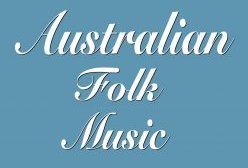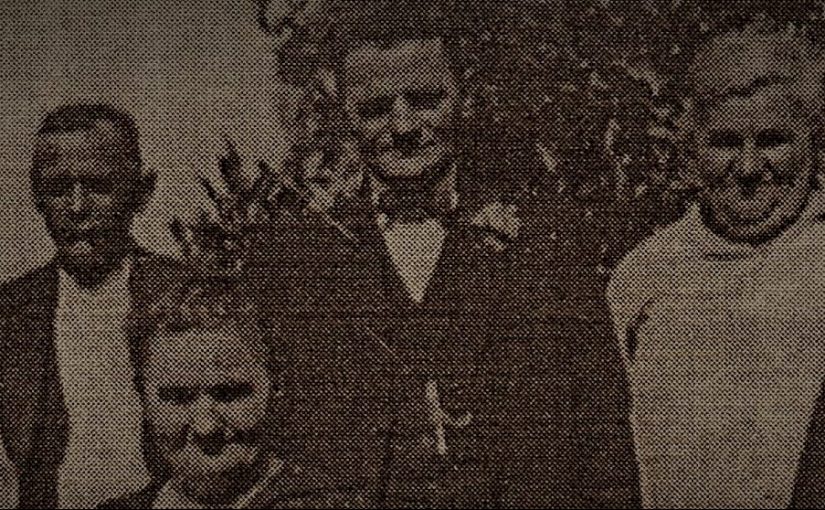
The story of the Schaefer
manuscripts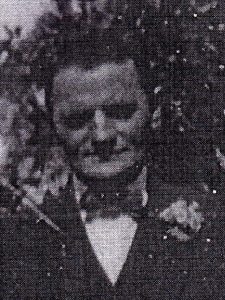
The name of Harry Schaefer was often mentioned by musicians around Forbes – accordion player
Dave Mathias , the concertina player Lionel Pietsh, Merve Hawke and Jimmy Collits; the old time dance musicians all spoke of him with reverence. I had
also heard of the shed full of musicial instruments
that Harry was rumoured to have left when he died.
‘It’s a pity you were not around to have a yarn to him’, they said.
Apart from the images of Harry riding his push bike to dances, violin and drum strapped to his back, there were also stories of a collection of music that he had handwritten over the years. The first indication that some music may have still been in existence was when Mrs Helen Bernardi, daughter of the late Martin Debenham of Forbes, gave me copies of some of her fathers handwritten tunes, and commented that Dad had played music with Harry Schaefer and a lot of the tunes were from him.
It is amazing how often an innocent remark leads to an event. I was browsing in the Eureka second hand shop and talking with one of proprietors, Mrs Marie Snow about music (not an unusual practice for me) when the name of Harry Schaefer surfaced. The proverbial feather could have knocked me over when Marie mentioned that she had some manuscript books of Harry’s. Would I like to see them? Could I find a safe place for them if she gave them to me?
The books had been obtained by a close friend, Mr Joe Hohnberg upon Harry’s death in 1954. In turn they had been passed on to Joe’s son, Steve and in turn to Mrs Snow. I am certain that Harry Schaefer would be pleased and proud to know that his music is again being played.
Thanks are due to: Steve Hohnberg, Marie Snow, Naomi Steinhardt, Sue Petersen, Shirley Hohnberg, all the Wongawillians, Olya Willis, Biddy McClenahan, Ivy McClenahan and all those I’ve interviewed.
Rob Willis
Forbes 1995
Harry Schaefer
Harry Schaefer died in Forbes on May 22, 1954 aged 79 years. He was the youngest of eight children, born on November 11, 1876 at Echuca, where his parents had settled. His father, Carl, had emigrated from Rhenish Bavaria in 1857, and had met Anna Lorke, originally from Prussia, while living in Germantown, near Geelong. They were married in 1862, and moved to Echuca sometime between 1864 and 1867. Carl had been a musician in Germany, but the family history suggests that Carl Saw being a farmer as a more suitable occupation for Harry, and discouraged his music-making.
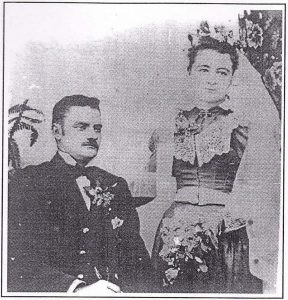
A “short stocky bushman”, Harry was involved in farm work in the Forbes and Parkes area for most of his life. He married Adelgunda Helene Miegel at Euchuca in 1899, and the photograph on this page was taken at that wedding. They moved to the Forbes district shortly after, where they bought a farm. A child was born the following year, but died shortly after birth, and Adelgunda died the following year.
He married again, some years later, to Annie Dempsey, who died in 1920, and served in the AIF during the First World War. There doesn’t seem to have been any other children. He is buried in the Forbes Cemetery, with his grave marked by a simple wooden cross.
The variety of instruments played by Harry was truly amazing -fiddles, Strohviol, flute, tin whistle, piano, clarinet, accordion, cornet and other brass instruments are among those mentioned. Harry was also a member of the Forbes Town Band some of the dance music in these books is obviously written out for brass players.
Extensive recordings from both friends and family of Harry Schaefer have been, and are being obtained for the Oral History and Folklore Archive of the National Library of Australia.
The manuscripts will also be lodged in the Library when the project is completed. The extracts on the following pages are from those interviews recorded by Rob Willis.

” I think the most vivid thing I remember of Uncle Harry was his appearance, stocky-you know, a real bushman-and his love of music. ”
Ivy McClenahan:-Harry’s Great Niece.
Harry’s father wouldn’t even teach the boys so they used to have to steal his violin. I don’t know whether you have ever seen one of the old, what they call the old strippers they had years ago For stripping the wheat before the headers came out. Well, they had a great big box on the back of them and they used to get the old chap’s violin and they’d hide in there and learn to play it -that’s how they all used to play music.
” He used to ride a push bike -strap the old violin around his back -always used to ride the push bike from Parkes out here -usually had a tin whistle with him as well. He could play anything. He had a flute -he could play anything you gave him, and he was all self taught. ”
Biddy McLenehan -Harrys neice
” Harry Schaefer -anything you’d ask him he’d play it -any instrument you’d put in front of him he’d pick it up and play it just like that. ”
Lionel Pietsch -concertina player and a friend of Harry
I think I was first introduced to him by Bill Cade (old time fiddle player from Forbes), and I got to know him as an old time dance band player in the area, commonly used in woolshed and so forth around. But he seemed to be able to play pretty well all the instruments, violin, Strohviol, piano accordion, he seemed to have a variety of instruments down at his place .
“… when I saw him playing it would all be by ear … he was very quick at picking things up. If you played a tune a couple of times, even less than that, he’d sort of get hold of it and go away with it, where we’d have to play it over and over again to get hold of it. ”
Merv Hawke -musican and dance bond player
We went out to Inchgower ( a woolshed) to put on a dance to raise funds for the ambulance -and some wise character said ‘Where’s the orchestra?’
I said ‘That’s it over there -that man with the violin on his lap’. Harry Schaefer -only bloke there -and boy could he play, wasn’t two ups and he had everybody on the floor, happy as Larry -one violin.
He played almost all over the place on his own. You see every year they had a school picnic dance at Wowingragong (School) and he was the orchestra -one man on the violin -Oh yes.
See, Harry Schaefer wouldn’t buy a piece of music -No he was too miserable -No he’d hear something on the wireless or another band playing it-He’d go home and write it out-stop in the head -write it out himself-by golly boy.
Joe Hohnberg:- founder of the Forbes Ragtime Band and close friend of Harry Schaefer. I always remember he went right to the very margin -he’d draw the pencil lines right out so to get that extra centimetre of paper.
(All of Harrys manuscripts had the printed staff lines extended in pencil to the very edge of the page. He managed to squeeze an extra bar of music in this way and save manuscript paper )
The violin was his strongest instrument-
Rob:-Do you remember some of the others he played?
The Strohviol, Piano Accordion’ Clarinet, Violin, Piccolo, Flute, Harmonica, Flageolet, Drums. I couldn’t list the full 17 instruments [Harry played] -I know he had 17 he constantly used that figure, that he could play that number. I can’t remember the rest -he had a foot operated bass drum. He’d carry the bass drum round on his back, you know for dancing. You need a drum beat -and the drum was in a wool bale.
Rob:-Would he play the (bass) drum and the violin at the same time?
Yes, it wasn’t a bad arrangement for a dance -you do have to have that situation to keep a beat. They’re dancing and they’ve got to have a beat.
He didn’t like the Saxophone -I know that -He didn’t like the saxophone groups that were starting up in the big bands -and I always remember Harry saying ‘Them POOPIN’ Saxophones’ -Poopin’, that’s what he used to say.
Neville Kerr:-musician and protege of Harry.
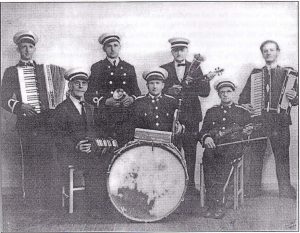
… I used to go down to old Schaefer’s and he’d have all these instruments in a little room about 10′ by 6′ or something … just a little shed, a little tin shed. I don’t think it had a window in it, only had a door in it. I think it used to be a little hot box.
Then we started up the ragtime band, Forbes Ragtime Band -that was during the war. We used to play at Grenfell and all around. I remember we were over at Grenfell one night and they were going to take our photo and I said to the bloke, “You turn around and fit us in whereve you think it best. ” “Well,” he said, “we’ll get a piano accordion on either end. ” And then we had the drummer sitting in the middle and Harry Schaefer loves racing around, he didn’t know we were going to get out photo taken. He always used to get on my treble end and he’d say “Now, I’ve got to get near Jim”
Anyway we were jostling around and I said “Harry, you’re only getting your photo taken”, and he was that bewildered he leant right over and touched me on the shoulder with the bow and he said “Now play me something we know real well because we’re on the air.” He thought we was on the air.
We used to get Harry sometimes to play at Tom’s Lagoon school -playing for the dances and that’s how he’d turn up -on the bike -drum on his back.
Jim Collits -musician and dance band player with Harry
When we went into the shed everything was so compact – hanging up off the unlined roof – even the bicycle was hanging from the roof. He had a forge in there and if you went there he would light the forge and boil the billy on the forge. And the smallness of the shed I’d say it was 10 foot by 6 foot roughly – and all his instruments were hanging from the ceiling. I believe he could play 17 instruments There was just a couple of chairs and a bed and all the instruments – there did not seem to be a window or anything.
I went to a ball at the Town Hall at Forbes with my parents and Harry Schaefer was playing – he was the sole instrument there and he played the Strohviol – no drums no accompaniment – and he played there all night and that would have gone from say, 8 o’clock to 2 o’clock in the morning – amazing feat for one person to hold a crowd like that.
Steve Hohn berg:- Son of Joe Hohnberg founder of the Forbes Ragtime Band.
Harry’s Music
These ten books of tunes provide a unique picture of the dance music of one part of Australia over a period of close to a century. Where other dance musicians have listed the tunes used for a particular dance (such as Harry McQueen did on cards kept in his accordion case), this collection might well be the only existing example of a bush dance musician writing down his repertoire of dance music.
Harry Schaefer was born in 1875, into a family where at least the father played music and, perhaps rather cunningly, interested his children in music by forbidding them to touch his violin. It would seem probable that a young Harry Schaefer learnt tunes from other musicians in the Echuca district where he was brought up. There are several tunes in the collection with names from around the Murray River – the Echuca Waltz, for one.
The region around Forbes had only been settled since the goldrushes of the 1850s, and it is likely that Harry learnt tunes from musicians who had been there since that time after he arrived in the Forbes district just after the turn of the century. He seemed to be adding to his repertoire until at least the 1930s or 40s, and was playing those tunes for some years after that. As Rob Willis’ interviews suggest that Harry Schaefer was a major, if not the major, figure in the district’s dance music for the first half of this century, these handwritten books of tunes can be seen as a musical history of this part of NSW, and as such, among the most important documents pertaining to dance music in this country.
The diversity of the dance music in Harry’s books reinforces the concept that a traditional dance player did not differentiate between older tunes and popular song tunes of the day. The main concern was that they fitted the tempo of the particular dance. It is interesting to note that Harry listed that actual dance alongside the name of the tune eg “The Fair and the Brave -Gypsy Tap”.
Several of Rob’s informants have suggested that Harry wrote the tunes out for his own reference, after learning them aurally from older players, or perhaps in later years after hearing tune ;n the wireless or on a gramophone record. The fact that several other musicians had written out tunes from Harry also suggests that this was a way of distributing tunes to other musicians who may
have been more sight readers that ‘ear’ players.
A number of the tunes in the manuscript books are well known with different names, especially the older ones which might be considered ‘folk tunes’ rather than popular music of this century, and this also suggests that they were learnt aurally from other musicians. The three polkas that have been transcribed are common to the repertoires of many dance musicians in Australia, but we
can only wonder who ‘Violet’ was, and where ‘Suttan’ can be found.
It is likely that we have transcribed several tunes in this book which are copyright to their various composers or publishers. Most of the fox-trots, and popular dances of the inter-war years are obviously popular, published tunes of the era, and we have not included them, but a glance through the list of the tunes in Harry’s manuscript books will give an idea of the volume of music that Harry played. In publishing this book we are trying to give an idea of the scope of material used by dance musicians such as Harry Schaefer, and have concentrated on tunes that are most likely in the public domain. Our apologies for any breaches of copyright, but the transcriptions are of what Harry wrote down, and it will be interesting, when time permits, to compare his
versions with the published ones.
We have tried to transcribe the music as it is in Harry’s books, but he had a somewhat free approach to things like pick-up bars, and occasionally the number of bars in a tune. Mazurka No 2, for instance, was notated with 17 bars. Bob McInness has kindly edited several of the tunes into more playable form, but any errors or departures from usual notation conventions are inevitably mine.
Graham McDonald
Canberra 1995
The Music:
Harry Schaefer Music Pages
Download the complete book here: 
